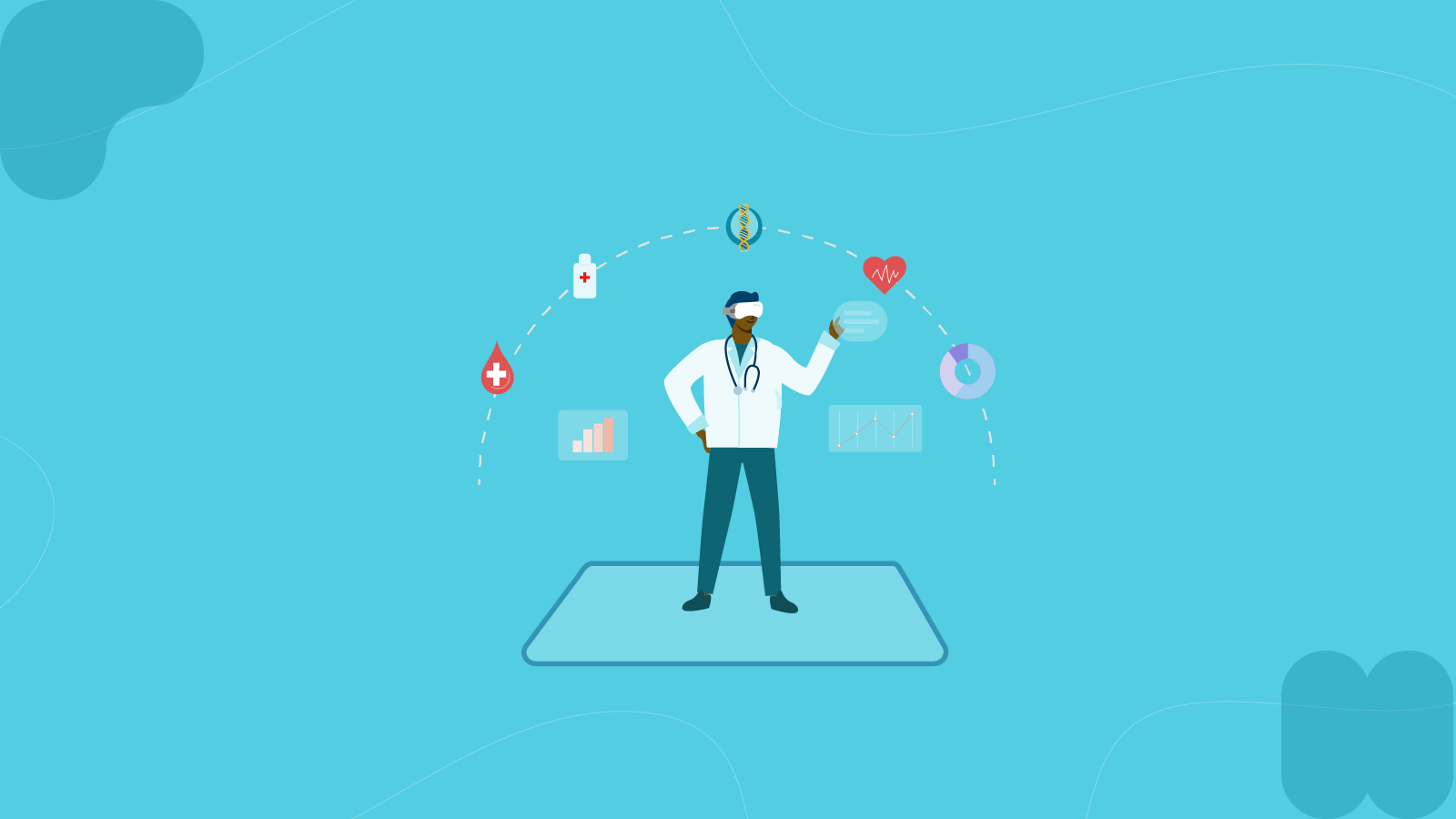Navigating the Future of Healthcare: The Tech-Powered Patient Journey
In the smart city of the future, you can book medical appointments through your phone virtual assistant. You will have a series of monitoring tools at home, and technology will help predict any situation that requires urgent medical attention. With monitoring tools, you will keep track of the medication supply you need daily and receive alerts with recommendations, remembering the time, type of medication, and how your body responds to your medical treatment.
You will have access to telemedicine, where through virtual environments or a metaverse hospital you will be able to recreate the feeling of being in a real doctor’s office. With quick consultations and efficient care channels, any patient will be able to have adequate care in a matter of minutes. If you need in-person medical attention, you do not need to wait in lines and your medical history information will be just a click away from any treating doctor.
Technology will be at the service of citizens, empowering your doctors to analyze, predict, and treat diseases. Digital care channels will be available promptly to provide guidance on the use of medications and obtain information about available medical services.
This description may seem like a utopian and dystopian fiction story. Still, it describes innovations, technological developments, and efforts of health entities worldwide to provide a better quality of care and an improved customer experience in healthcare. Incorporating fast-forward thinking is fundamental to long-term strategies. It encourages companies to not only dream of a common and shared vision but also allows teams to be more creative, implement an innovative vision, assess capabilities, and work around limitations, especially if you are on a budget restraint.
A recent survey conducted by McKinsey, Where is customer care in 2024?, talks about the importance of using and developing customer care tools based on Artificial Intelligence to improve the customer experience. According to the report, industry-leading organizations see the benefits of implementing new technologies and digital channels supporting the work of their agents, impacting activities such as call volume forecasting and customer service satisfaction levels.
Rethinking the patient’s experience combines technology, tools, processes, and people. As a patient and consumer, your health journey includes pharmaceutical industries and public or private health providers, among other entities crucial for primary health care and quality health services and products.
Design the medical customer service hub of the future by addressing the state of your current customer service channels. Discover diverse tools and technologies being implemented to identify improvement areas required for the healthcare industry.
The Medical Contact Center
Establishing a contact center for the healthcare industry implies developing a comprehensive understanding of the patient experience. According to a McKinsey article, The next frontier of care delivery in healthcare, published in 2022, “patient centricity is meant to be convenient, transparent, and personalized, where consumers expect to be treated as whole people with individualized needs, not as problems to be solved”.
Redesigning the patient experience involves solving barriers and blockers and understanding their needs, resulting in building a relationship of trust, safety, and well-being. Being one of the most traditional channels in the industry, contact centers represent the most effective channels in various countries. It is one of the most used channels for event reporting, first aid guidance, incident management, or emergency care. Through personalized campaigns, users can learn more about health services according to their needs and health conditions, improving patient satisfaction or the medical service utilization rate.
Like any other channel, providing information in real-time, managing the availability of medical appointments, escalating complaints, and claims are essential. In a medical contact center, solving waiting times and training contact center agents on empathy skills are critical and have an impact on patients’ progression and case resolution. In addition to the challenges of operating and maintaining each of these customer service channels, there are also challenges presented by the compliance regulations and standards established in the countries in which they operate.
Identify Your Contact Center Efficiency Metrics
Imagine a patient calling to book a medical appointment, interacting with a voice response system where booking options are unavailable, a helpline that will never respond to a call related to your medical services, or even an emergency line that can’t process your ambulance transport request.
Contact center managers need metrics to successfully measure agent performance and improvements to contact center operations. The following metrics are fundamental to setting the basis of an excellent customer and patient experience in your medical contact center:
- Hold Time: How much time will it take to contact an agent?
- Transfer Rate: Do I need to transfer the call to other departments for appointment management?
- First Contact Resolution (FCR): Do I have the tools and information necessary to resolve a patient inquiry, schedule an appointment, and provide information in real-time?
- Average Handle Time (AHT): How much time will I spend with every patient?
- Patient and Customer Satisfaction (CSAT): Will my customers fill a telephone survey collecting their feedback at the end of their call or will they receive an email following up on their experience?
Related Resources: Contact Center Glossary.
Real-time management tools and data analytics improve your customer experience. Keeping your customers informed and happy will result from prioritizing metrics that provide timely responses and adequate resolution.
Empowering Agents for Medical Empathy and Healthcare Literacy
It is essential to train agents on the existing portfolio, identify the right departments for case resolution, and reduce waiting time. Most medical contact centers have hybrid and specialized agents: students pursuing medical or technical degrees. Depending on the type of services the contact center offers, it is essential to guide agents on the type of memberships, service levels, or coverage that patients have for primary care or specialized care.
Agents’ training and coaching on topics such as medical terms, the platforms that patients must use, services availability, administrative changes, updates concerning patients’ access and coverage, or even disaster and contingency plans enables better handling of situations that might arise with contact center management and operation.
Hiring specialized agents with various medical specialties facilitates building a relationship with patients; they can act as mentors and health coaches, support customer service protocols, and improve assertiveness, empathy, and humanization in care. By incorporating the best of both worlds: medical knowledge and knowledge of contact center operations, organizations manage to cover necessary aspects to establish better patient care: providing updated information or even identifying strategies to lead surveys or focus groups to determine the needs of their audiences or the delimitation of parameters to comply with regulations and standards.
A fundamental aspect of agents’ success lies in their knowledge of the technological platforms they use. Providing the best response in the shortest time comes also from technological training. Training and learning paths must cover fundamental aspects crucial for your business. Consider IT literacy, contact center technology training sessions, management of 24/7 emergency responses, adequate onboarding of the service portfolio, and guidance on mental health, and social and emotional skills that benefit patients and provide emotional support for agents.
Patients Inspire the Digital and Technological Experience
Technology leverages how your patients, and ultimate customers, are heard, understood, and cared for. Operational efficiency, cost reduction, customer experience, agent engagement and establishing contact center technology investment ROI are pivotal in setting up your medical contact center strategy.
Worldwide, healthcare organizations have different customer service channels. Those organizations with various channels must prioritize the importance of traceability of requests, the registration and documentation of information, and the visibility of each patient’s information. Some entities even need more capacity to respond to comments on social networks and cannot sustain a multi-channel customer service strategy.
Regardless of the size of your company, whether it is a spa in a small city offering a well-being premium service, a yoga center, an entity that provides dental services, or an alternative medicine center, all customers will need their experience to be simple, informative, and designed to resolve the initial reason why they contacted the contact center in the first instance.
By combining the right contact center platform technologies with Playvox Workforce Management and Quality Management solutions, your medical contact center will cover a 360-degree approach that considers both a patient and agent experience that will benefit agent productivity, enhance accurate forecasting and even enable sentiment analysis through an AI-infused quality management system.
Tools and Technologies Used to Improve CX in Healthcare
Metaverse
According to a PwC study, The Future of Healthcare in the Metaverse, creating a virtual ecosystem simulates the experience of a medical consultation, enabling a conversational space between doctors and patients to learn about the medical services to which you have access or receive a consultation without physically traveling to an office. The combination of a virtual and physical environment enables an interactive experience for patients with a virtual space created in 3D that allows simulation of the real world.
With the use of other technological tools, such as Virtual Reality or the creation of digital twins, exact replicas of customer service offices and medical cubicles can be created, and patients have access to the metaverse hospital in the form of avatars. In the process of use and adoption, the report highlights that understanding the metaverse requires training sessions and a strategy to guarantee aspects such as personalization, interoperability, and visibility of patient information. Connectivity challenges and technology access are now essential elements to guarantee a good experience for the patient.
AI and Robotics
With the implementation of AI, benefits are offered not only for patients but also for medical staff who will be able to dedicate more time during the consultation for diagnosis, instead of investing it in paperwork and administrative procedures. According to a PwC report, No longer science fiction, AI and robotics, as well as automation, are transforming healthcare, improving training, research, patient assistance, treatment, and supporting decision-making for treatment or early detection of diseases.
Instant Messaging
Instant messaging continues to be one of the most used channels in various countries. Through a text message, you receive confirmations of consultation payments and medical appointments with specialists, reminders and even the follow-up of prior authorization requests, and additional information that a patient may require for medical treatment. Some challenges to guarantee adequate service arise in choosing an appropriate provider to manage user capacity and campaign personalization, assuring patients receive the right information at the right time. Orchestrating an adequate communication strategy according to the patient journey is essential as updating or restoring patient information in a timely manner for the SMS database.
With the implementation of Customer service chatbots and digital assistants, it is possible to create a greater relationship of trust with patients and establish proactive conversations with more impact for users with tools like WhatsApp. From the automation of medical appointments, agenda reminders, consultations, or even the implementation of microlearning programs, this tool becomes a great alternative to support marketing activities and keep track of the consultations made by patients with less resolution time.
Telemedicine
During the COVID-19 pandemic, this tool was mainly used to enable patient care, consultation, and medical treatment. With the confirmation of a medical appointment, only a cell phone or a computer with a camera was required to access the consultation with the specialist. Describing symptoms and accurately diagnosing became a great challenge for doctors and patients. Telemedicine systems have even been implemented worldwide to facilitate comprehensive care on procedures, requests for specialized care, or escalation of claims and complaints, benefiting at-risk patients.
Communication via email is a valuable tool to manage information more securely, enabling greater ease of consultation, handling sensitive issues, or even training the healthcare workforce. This channel continues to be a challenge for senior citizens, who need to gain sufficient knowledge of technological tools since it represents opening an email account or downloading documents.
Reshaping the Patient Experience
In an industry that adapts and evolves with the demanding needs of patients to assure quality health services and more channels that guarantee information access, healthcare organizations are embedding innovative programs to transform their customer and patient experience.
Having the right channel is just one element of the transformation process a customer experience in healthcare might need in the future. Diverse organizations worldwide are investing in social media monitoring, offering personalized care, leading their organizations into culture change and digital transformation strategies, or even implementing patient feedback tools and sustainability and environmental programs to reuse medical devices where patient engagement is essential for successful implementation.
In the Playvox Resource Center, we share essential aspects for establishing a Contact Center, understanding age and generations, and their preferences for various communication channels, along with recommendations to establish an omnichannel service program and identifying metrics and objectives.Learn more about how Playvox Workforce Engagement Management can support your omnichannel strategy and help your company improve patient and customer experience in the healthcare industry, here.





